|
I have become increasingly aware that some very fundamental misunderstandings of this very important type of power amplifier have been repeated over and over again in various texts printed in the last half-century, so that they are now widely believed to be true. I recently read that the beam plates in a beam tetrode are connected to the screen to collect secondary electrons. They are always connected to the cathode to repel primary electrons and prevent them from entering regions of the screen to anode space in which a virtual cathode cannot form due to the geometry of the electrodes, which in early types, e.g 807, 6L6, KT66 etc., was determined by the need to build the valves using existing techniques that could not produce the required construction. Modern designs of beam tetrode use an electrode geometry which enables the device to achieve its full potential, resulting in higher efficiency, much higher output for a given size and operation from audio to UHF all without the use of beam plates.
I decided to write a short monograph which, as usual with my offerings to the BVWS is aimed at a wide readership and as is usual in such articles is less than a rigorous treatment of the subject. I trust that some may find it useful.
The story starts with the screened-grid tetrode which was developed to minimise the anode to grid capacity by interposing an electrostatic screen at HF earth potential. The screen was so effective that it prevented the field from the positively charged anode from penetrating to the grid. Thus electrons passing through the grid having no anode field to act upon them went no further. The cure of course was to put a positive bias on the screen to help the electrons on their way to the anode. The resultant device was a great success, revolutionising HF amplification, but it had a serious problem: the tetrode kink, which rendered it unsuitable for large signal handling (power amplification).
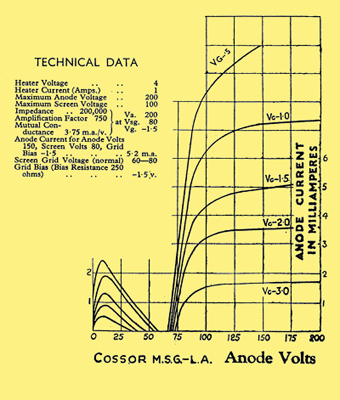
The problem was caused by anode secondary emission. Any thermionic valve operating at an anode potential above 10 V emits secondary electrons from the anode as a reaction to the bombardment by primary electrons from the cathode. These secondary electrons are attracted to the most positive electrode which in the case of diodes and triodes is the anode. If all the secondary electrons emitted by the anode return to it, the net secondary emission current is zero therefore we cannot detect any effect.
In a tetrode we have a second positively biased electrode (the screen) which also attracts secondary electrons. If all the anode secondary electrons do not return to the anode, the net anode current is the number of primary electrons from the cathode minus the number of secondary electrons captured by the screen thus the anode current falls, producing the tetrode kink (see above). As the dynamic anode voltage swings down following a signal, a point is reached when the almost constant anode current begins to drop very rapidly. When the anode potential approaches the screen bias the anode current begins to drop very rapidly. When the anode potential is less than the screen bias the screen is the most positive electrode and collects virtually all the secondary electrons and since at an anode potential of 40 or 50 V these can outnumber the primary electrons, the net anode current can fall to zero and even go negative.
Clearly the screened grid valve has its anode excursion limited to less than the difference between anode and screen supply potentials and since screen bias is typically 2/3 anode supply or higher, large signal swings are not possible. The obvious answer was to introduce a third grid connected to cathode and placed between screen and anode to repel secondary electrons back to the anode, thus suppressing the secondary emission effects. This is of course a pentode - a very successful power amplifier, but not the best solution.
There are other ways to force secondary electrons back to the anode. Valves have been produced with very wide anode-to-screen spacing so that the screen potential has little influence upon secondary electrons while they are still close to the anode. Another approach is to add projections to the inner surface of the anode, but a side effect of the virtual cathode produced in the beam tetrode makes it superior to all other forms.
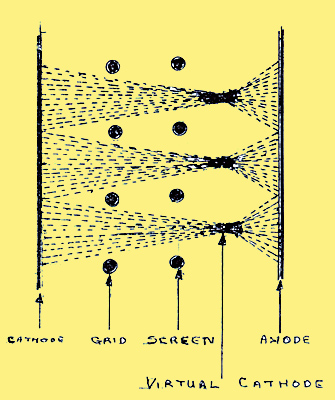
The beams, which give the beam tetrode its name are flat sheets of electrons which pass between the grid and screen wires on their way to the anode. They are not formed by the so-called beam forming plates which were put into early forms of the device to enable established methods of grid and screen production to be used, so avoiding the cost of new tools and assembly techniques for one specific valve type. The confusion began when these plates called 'beam confining' plates began to be called 'beam forming' plates in post WW2 publications and for some reason this misnomer was universally adopted. The potential for misunderstanding was compounded when the same publications began to say that the unique properties of beam tetrodes came about from the formation of a virtual cathode, (which is true), without saying what the nature of the virtual cathode was, how it is formed or what it does to the valve characteristics.
The defining feature of any beam tetrode - whatever its form of construction, is that the grid and screen are helices wound to exactly the same pitch and assembled so that corresponding wires in grid and screen are precisely in line. Thus each screen wire sits exactly in the electron shadow of the corresponding grid wire. The electric field between grid and screen compresses the electrons passing between the grid wires into flat sheets. These are the beams which give the device its name. The electrons passing through the grid and screen are squeezed together until somewhere between screen and anode they reach a limiting density determined by the mutual repulsion between electrons which limits how tight you can pack them. Beyond this point of maximum density, the electrons are little influenced by grid and screen and quickly spread out into a fairly uniform cloud (see above).
Focussing the electrons into flat beams has three important effects. Very few primary electrons are captured by the screen compared to a pentode where the screen current may be up to 20% of the anode current. In a beam tetrode it is only a few percent. At the point of maximum electron density, shown as the dark wedges in line with the spaces between the screen wires, the conditions are like those at the surface of a space charge limited cathode where mutual repulsion prevents further emission. In three dimensions these spots of high density electrons form a helix with the same pitch as the grid and screen. This produces a virtual suppressor grid but if that were all, beam tetrodes would be little different to pentodes.
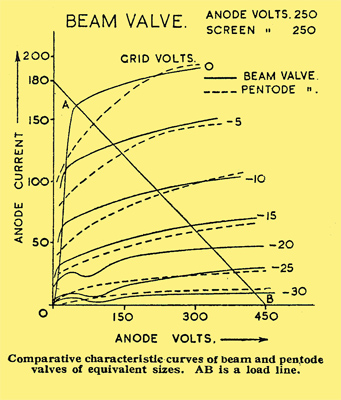
Viewed from the anode, the electrons appear to come from a cathode located between screen and anode. At low anode voltages the device functions like a space charge limited diode. If you carefully measure the initial rise in anode current from zero it exactly fits the three halves power law of a diode. At quite low anode voltages this diode characteristic abruptly switches to the near constant current characteristic of a pentode making a very sharp knee. This enables beam tetrodes to provide low distortion amplification over much more of their anode characteristic than a similar size pentode, and to operate with high efficiency and produce more output power (see above). This made beam tetrodes preferred devices for audio and radio frequency power applications. So why use beam confining plates? In the 1930's the preferred construction for high-powered valves used an electrode section in the form of flattened tubes. The anode tube was supported at the ends of the long sides by rods sealed into the glass pinch at the tube base with grids of similar form with wires welded to support rods, with the ends fixed in place by mica support plates. The problem was that the necessary conditions for proper operation of the virtual cathode could only be obtained over the rectangular centre part of the assembly. The solution was to fit metal plates inside the curved ends of the anode tube to prevent electrons passing through the curved ends of the grid and screen from reaching the anode (see below), hence beam-confining plates.
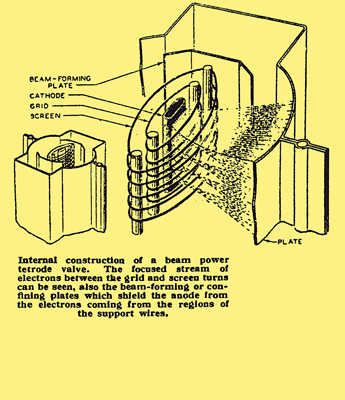
Some texts say that the grid and screen support rods caused problems but I doubt that these were major because they only interact with a tiny fraction of the total cathode emission. This form of construction gave devices with significant advantages over pentodes of similar size, but as you can see the introduction of beam-confining plates means only a fraction of the anode and cathode surfaces do any useful work. The valve in this form achieves only a fraction of the potential of the beam tetrode.
For completeness I suppose I should briefly describe the more modern forms of the beam tetrode. Some may say it is not vintage radio but it predates transistors and I see a lot of them in the Bulletin. In the modern form all the electrodes, cathode, grid, screen and anode form concentric cylinders. The grid and screen wires are of course optically aligned. Thus if the conditions are set up right, a virtual cathode is produced over almost 360 degrees using all the cathode and anode surfaces. The grid and screen support rods only intrude into a tiny fraction of the cylindrical arcs and have a negligible effect. Valves of this type are usually designed to operate with screen voltages only about 15% of the anode voltage compared to about 50% in the early types. This enables them to swing over a much larger anode excursion increasing the power output and making them even more efficient. These valves have a very small screen current usually near zero, because when the anode is swung right down below the low screen potential, there is some screen secondary emission and the screen current could be negative. These valves consequently need a regulated screen supply which will sink or source current, (a shunt regulator). The screen cylinder in these valves is joined to a metal cone which extends from the diameter of the screen to the full internal diameter of the valve base, thus the grid and cathode are totally shielded from the anode enabling high power amplification at VHF without neutralisation. VHF and UHF power amplification is the forte of these valves but they are equally good at high power audio. When they appeared towards the end of WW2 the existing older types continued to be used for anode dissipations up to about 25 W and scaled up to about 40 W (KT88 and TT21). The new design was used for a series of valves with anode dissipations from 65 W to 1 KW in glass bulbs and with external anodes for air conduction cooling from 250 W upwards to multi KW types with water cooling.
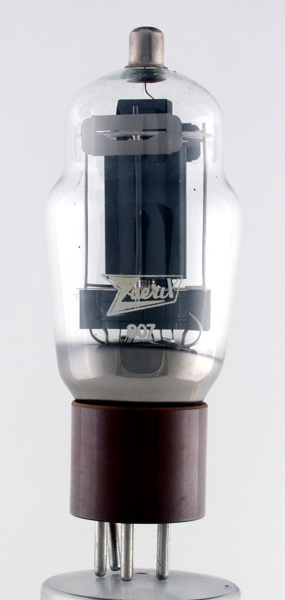  
Compare the late 1930's classic type 807 with a rectangular anode and beam confining plates which uses only about 1/3 of the anode area to give a maximum dissipation of 25 W and a maximum frequency of 60 MHz with the post WW2 QY3-125, with a cylindrical electrode assembly without beam confining plates of a similar size to the 807 electrode assembly. (The large rings round the outside of the QY3-125 anode cylinder are heat radiators). This valve has an anode dissipation of 125 W with full ratings up to 120 MHz. As an audio power amplifier, a pair will produce an output power of 550 W at an anode efficiency of 72.5%.
In the external anode form, the electrode cylinders were continued as metal tubes to the outside of the valve and were designed to connect directly to VHF/UHF coaxial anode and grid circuits; this gave them UHF performance up to 1 GHz and high power up to many KW in a physically small size. Two of the smallest members of this family are shown below (see also QV1-150A for construction), one air-cooled and one conduction-cooled, having an anode cylinder 0.5 inch inside diameter, giving a dissipation of 250 W up to 500 MHz or 600 W audio for a pair. By 1960 the makers data had dropped the name 'beam' and all were referred to as power tetrodes, there being no other type of tetrode capable of power amplification and the beam confining plates disappeared from the circuit symbol as they had from the inside of the valves.
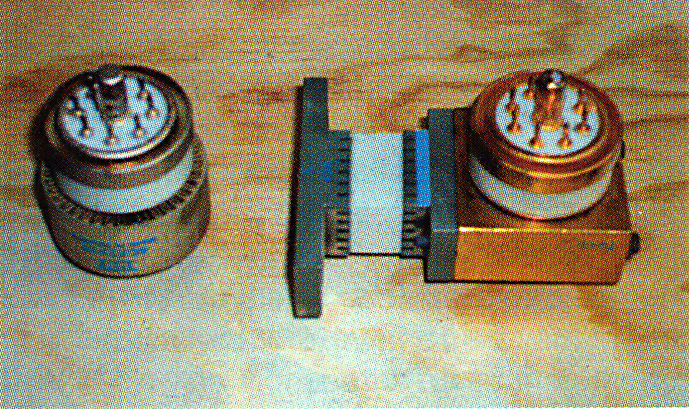
Having extolled its virtues I will probably get taken to task if I fail to mention its major defect. If the transfer function of a beam tetrode power amplifier (the law connecting input signal to output) is examined it exhibits pronounced even order curvature. This implies that at full output considerable even harmonics of the input frequencies will appear in the output. Dealing with this by applying heavy negative feedback greatly reduces the devices' very high sensitivity, one of its virtues. The ultra linear connection which may be considered as anode to screen negative feedback, yields lower distortion for some loss of sensitivity. In principle two identical valves having only even order curvature should be perfectly linear in a correctly designed perfectly balanced push-pull circuit and this is probably the best way to employ beam tetrodes for audio. For HF linear power amplifier use it is possible to select operating conditions to make the instantaneous output power proportional to the square of the input voltage (this is by definition a linear HF power amplifier). Beam tetrodes may be operated single-ended in this mode, delivering a peak envelope power typically three times the valve anode dissipation.
In 1965 beam tetrodes were the undisputed valve of choice for high power linear amplification from audio to UHF. There was however, a new contender on the horizon. By 1970 the digital computer, a child of the triode valve, had sufficient power to model the electron ballistics inside valves. This was used to tweak the electron ballistics of a triode to give it almost perfect linearity (IMD products as low as -50db were claimed). The same computing power was applied to optimise the circuit operating conditions to obtain much higher power outputs and higher efficiencies than had been thought possible and the very first valve power amplifier, the triode, superseded the beam tetrode as the valve of choice at any frequency up to 1 GHz. The same computer modelling applied to 1930's power triodes like the 811A, by radio amateurs, enabled them to produce twice as much power at much higher frequencies than their designers thought possible. 70 years old, the triode finally reached its potential. The tetrode, invented to overcome the limitations of the triode, had its limitations overcome by the return of the triode.
|